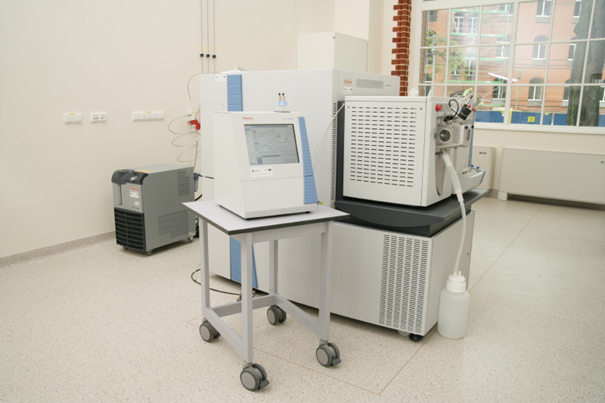Service Laboratory of the Center for Life Sciences and Biotechnology
The laboratory offers implementation of research orders in the areas of proteomics, metabolomics and quantitative and qualitative analysis using mass spectrometry (MS) and nuclear magnetic resonance (NMR) techniques. Our Laboratory support partners in development, validation and transfer of analytical and bioanalytical methods. We also provide services in the field of cellular analysis and imaging of biological processes occurring in live cells and tissues.
MEASUREMENTS USING THE NMR
- identification of molecular and macromolecular substances in solutions, homogenates and solid body,
- determining of chemical compound structure – chiefly organic, coordinative and bio particles,
- qualitative and quantitative determining of organic compounds,
- observation of dynamic particle transformations,
- following the reaction progress,
- variable temperature measurements
- proteomics: determining of protein structure, determining of reacting between proteins and small particles,
- metabolomic profiling,
- pharmacology: identification and purity of active pharmaceutical substances.
The Laboratory performs the qualitative and quantitative analysis with determining the structure of chemical compounds in the scope of:
- Proteomics: peptide analysis with the “bottom up” method and fragmentation type CID, HCD and ETD in order to identify proteins, post translation modification analysis (phosphorylation and glycosylation), peptide quantitative analysis (SRM/MRM), de novo proteins identification, “top down” method protein analysis
- Metabolomics: profiling and identification of metabolites in clinical samples (serum, urine) and tissue material, analysis of low molecular weight substances
- Lipidomics: separation and identification of lipids and derived compounds, profiling of cell and membrane lipids of plant, animal and human origin, quantitative analysis
- Pharmacokinetics: DMPK analysis of medicines and their derivates in physiological liquids (serum, urine), test of medicines and cosmetics components, identification and structure determination of medicines and dietary supplements
- MALDI Imaging: identification and analysis of protein and metabolites distribution in tissues
- MALDI Biotyper: an innovative method of identification of microorganisms in biological materials (bacteria, yeasts, fungi)

Łukasiewicz – PORT Polish Center for Technology Development
SPECTROMETER NMR AVANCE III HD 500 MHZ (BRUKER)
cross section measurements in solutions, changer for 60 samples, provided with probes: BBI and BBO
SPECTROMETER NMR AVANCE III HD 600 MHZ (BRUKER)
measurements in solutions (changer for 16 samples) as well as in a solid body and homogenates, provided with probes: BBFO, CP MAS 1.3 and 3.2 mm and HR MAS 4 mm
SPECTROMETER NMR AVANCE III HD 700 MHZ (BRUKER)
measurements in solutions using a cryoprobe QCI, changer for 24 samples, additionally provided with probes: BBO, TXI (P and N) All the spectrometers are provided with attachments for variable temperature measurements. The Laboratory has a dedicated room for sample storage.
Ultra-high resolution, hybrid mass spectrometer with Fourier’s transformation LTQ Orbitrap Elite (Thermo Scientific)
- mass analysers: LTQ (linear ion trap), high field Orbitrap
- exchangeable ion sources: ESI (HESI), APCI and Nano
- fragmentation CID, PQD, HCD and ETD
- ion mobility FAIMS module
- liquid chromatograph Easy nano-LC 1000 and Ultimate 3000
High resolution mass spectrometer QTOF Maxis Impact (Bruker)
- mass analysers: quadrupole and time of flight analyser
- exchangeable ion sources: ESI, APCI and nano CaptiveSpray
- fragmentation: CID
- ultra high-performance liquid chromatograph Ultimate 3000 (Thermo Fisher Scientific) Ultimate 3000 (Thermo Fisher Scientific)
High resolution mass spectrometer ultrafleXtreme MALDI TOF/TOF (Bruker)
- Biotyper for microorganism identification (bacteria, fungi)
- ImagePrep for tissue analysis with the MALDI imaging method
- fragmentation: CID, LIFT
- Proteineer fc II automatic robot
- liquid chromatograph Easy nLC (Bruker)
Mass spectrometer LTQ (Thermo Scientific)
- mass analyser: LTQ (linear ion trap)
- ion source: ESI
- fragmentation CID
- ultra high-performance liquid chromatograph Ultimate 3000 (Thermo Fisher Scientific) Ultimate 3000 (Thermo Fisher Scientific)

Łukasiewicz – PORT Polish Center for Technology Development

